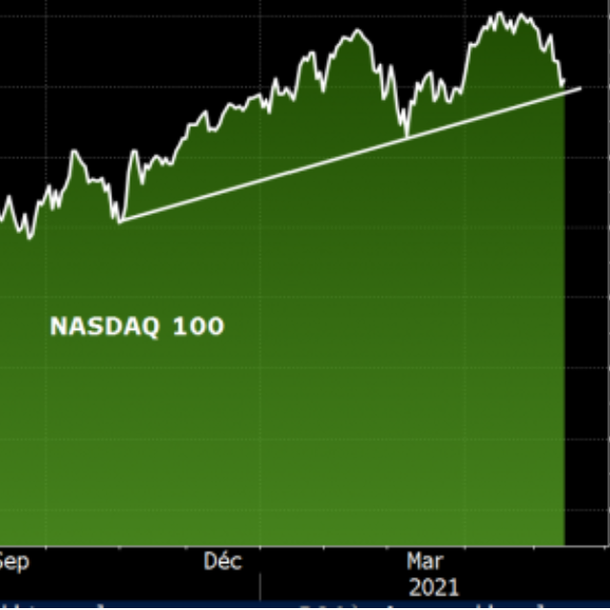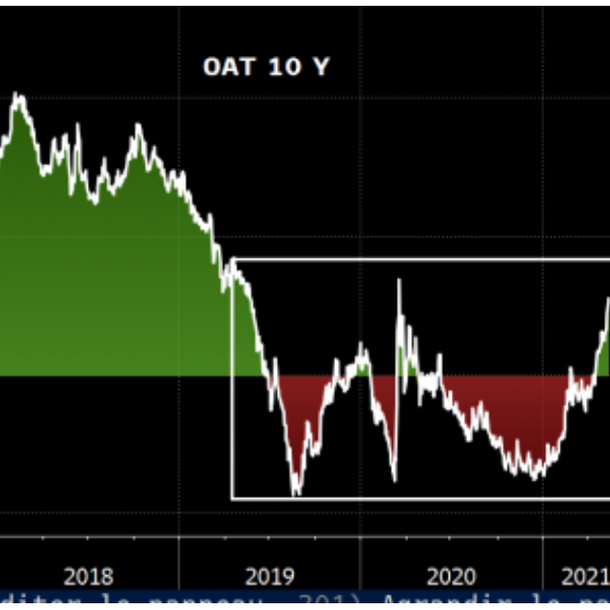|
Monday May 17 | Weekly market update |
 | Financial markets have experienced a very tensed week, due to US inflation statistics suggesting that the Fed will tighten its monetary policy more quickly than expected. However, the US central bank tried to reassure investors, mentioning temporary pressure on prices, and its willingness to maintain monetary support in the coming months. |
| Indexes Over last week in Asia, the Nikkei posted a weekly loss of 4.3%. The Hang Seng lost 2% while the Shanghai Composite gained 2.1%. In Europe,the CAC40 was down 0.3%, as was the Dax. The Footsie fell 1.4%. Concerning the peripheral countries of the euro zone, Spain was up 0.5%, Portugal 0.7% and Italy 0.3%. In the United States, the Dow Jones lost 1.4%, the S&P500 1.7% and the Nasdaq100 3%, preserving a long-term trend (see chart). Nasdaq100 back on a supporting oblique  |
| Commodities The cyber attack that temporarily paralyzed the Colonial Pipeline in the United States dominated the news in oil markets. This event naturally exerted upward pressure on fuel, but downward pressure on the price of crude oil (via a drop in US refinery activity). At the same time, OPEC said it was more optimistic about the state of demand in the second half of the year, which gave oil prices a bit of a lift at the end of the week. Brent crude is trading around 68 USD per barrel, compared to 64.5 for WTI. Despite a rise in bond yields, gold ended the week at a high of around USD 1840. In fact, investors could be very interested in the barbarian relic in case inflation rises faster than nominal rates, thus preventing any pressure on real rates. In the industrial metals sector, it is time to take a breather. Copper is losing ground at USD 10,200 per metric ton, aluminum is back to its early May level at USD 2,420 while tin is trading at USD 3,200. |
| Equity markets This week, let's have a look at the best performance on the ASX since the beginning of the year. Galaxy Resources is an Australian mining company specializing in mineral exploration and lithium production. The company is up 70% since January 1. A development that is due to the rise in raw materials for several weeks already. However, this increase is due in large part to the explosion in demand for the white metal, thanks to the boom in sales of electric cars. Late April, to meet this growing demand, Galaxy Resources and Orocobre agreed to merge and increase their strength in the field. Both have a strong presence in Latin America. Analysts see future synergies and predict increased revenues and a positive and growing net profit for the years to come. Progression of the Galaxy Resources stock  |
| Bond market The rise in ten-year rates is real. In Europe, the Bund is approaching a symbolic zero (-0.11%) while the French OAT is in positive territory with a yield of 0.278% (see chart). U.S. consumer prices rose in April, intensifying the already heated debate on the duration of inflationary pressures. Rate traders reacted by increasing bets that the Fed might be forced to raise interest rates next year. Nevertheless, Federal Reserve Vice Chairman Richard Clarida sought to calm things by arguing that rising inflation was likely to be largely transitory. This will fuel commentary. Turning to European benchmarks, Italy and Spain are seeing the cost of their 10-year debt rise to levels not seen in several months, to 1.07% and 0.60% respectively. The same is true for the major Swiss bond, which is trading on a near-positive interest rate basis at -0.16%. OAT back to 2019 levels  |
| Foreign exchange market The dollar's trajectory is showing more volatility after the surprisingly strong U.S. inflation numbers. As a result, traders have revised their bets on the outlook for rate hikes across the Atlantic. After taking the brunt of the blow, the EUR/USD is heading back towards its recent highs around USD 1.213. The British pound continues to recover dynamically. This trend is being verified against the euro, with the GBP/EUR pair returning to its one-year highs at 1.1. The British currency was trading against the dollar on a 1.40 basis on Friday (see chart below). These bullish runs have been influenced by local election results where the Conservatives made a breakthrough in a Labour stronghold and by a much improved domestic health situation. Against the yen, the British currency even gained more than 400 points to JPY 154.2, a three-year high. Despite the stress detected in the equity markets, the yen, a safe haven, remains in the back of traders' books. The EUR/JPY pair took advantage of the situation to set a new two-year high at 132.4. In the southern hemisphere, the local dollar declined over the week despite the persistence of tensions on commodity prices. The Aussie is indeed relatively correlated to commodity price developments. The AUD/EUR (0.64) and AUD/USD (0.77) fell by about 150 basis points each. On the other hand, the Canadian Loonie is taking advantage of the current economic situation to accelerate again against the greenback to USD 0.82. Cable evolution  |
| Economic calendar Over the past week, inflation data clearly caught investors' attention. In China, the CPI index came in at 0.9% (consensus 1%) but the producer price index jumped 6.8% in April, an almost 4-year high. In Europe, the German Zew index exceeded expectations at 84.4 (72 expected) and industrial production in the euro zone rose by only 0.1%. The CPI index in France rose by 0.1%. In the United States, the data was very mixed. The CPI index rose to +0.8% in April (+4.2% annualized), the PPI index climbed by 0.6% (+6.2% over one year) and the import price index rose by 0.7%. On the other hand, retail sales were stable, industrial production rose by only 0.7%, but weekly jobless claims were better than expected at 473K. |
| A period of transition Equity markets have had an up and down week, marked by renewed volatility. These erratic movements highlight the passionate rhetoric that is emerging about the sustainability of outsized inflation. Are we experiencing a temporary spike in these price increases as a result of some post-crisis scarcity and the dynamic rebound in growth? Or are we entering an era of accelerating price increases? The debate will be heated and will remain at the heart of investors' strategic decisions. In any case, the context favors recent allocation choices. The flows remain very binary, as in the case of arbitrage in favor of growth stocks in 2020, or more recently of value stocks in 2021. These movements are accentuated by passive management, both on the upside and the downside, depending on the preferred themes of the moment. The stars of the last few weeks are financials and inflation-linked bonds. We can understand why. |

 By
By 

















